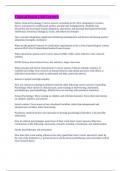Clinical Psych || All Correct.
Define Clinical Psychology? correct answers According to the APA: integration of science,
theory, and practice to understand, predict, and alleviate maladjustment, disability and
discomfort and to promote human adaptation, adjustment, and personal development•Includes
intellectual, emotional, biological, social, and behavioral domains
•Key concepts-Integration-Application-Reducing maladaptation and distress-Increasing positive
adaptation (strengths, resilience)
What are the general licensure or certification requirements to be a clinical psychologist? correct
answers Ph.D.•Psy.D.•Internship•Postdoc•Exam•License
What educational options exist? correct answers PHD: Older, more selective, more research
oriented
PSYD: Newer, more clinical focus, less selective, larger class sizes
What personal and ethical characteristics? correct answers Clinical Attitude: tendency to
combine knowledge from research on human behavior and mental processes with efforts at
individual assessment in order to understand and help a particular person.
Interest in people and high empathy
How are clinical psychologists different from the other following correct answers Counseling
Psychology: Most similar to clinical psych, same training in interviewing, assessment,
psychotherapy, psychopathology. Mostly focus on assisting with normative transitions
School Psychology: More training on children and child development. Focus their intervention
on children, families, and schools
Social workers: Focus more on how situational variables, rather than intrapersonal and
interpersonal variables, affect functioning
Psychiatry: medical doctors who specialize in treating psychological disorders. Can prescribe
medication.
How do clinical psychologists spend most of their work time? correct answers Most do a
combination of the following: assessment, research, teaching, consultation, and administration
mostly psychotherapy and assessment
How does their work setting influence how they spend their time? correct answers It varies by
the role of the institution i.e. private practice will be more psychotherapy and universities will be
more research heavy
,How have differing opinions about the balance of practice and research affected education?
correct answers Boulder-Model: Psychologists should be proficient in research and practice
(PHD route)
Vail Model: Alternate approach with less emphasis on scientific training and more on practice
What is eclectic approach? correct answers approach where techniques from a variety of
theoretical schools are employed
How might integration of different theoretical approaches be possible? correct answers
psychotherapy integration: systemic combination of various elements from different theories
How has managed care influenced practice correct answers Involves client clinicians and
insurance company, HMO or similar org. When third party influences who provides treatment,
what treatments are used, how long they last and so on it is managed care. Uses business
principles rather than clinical ones.
What is Mental Health Parity? correct answers Insurers must provide the same level of coverage
for mental illnesses as physical illnesses
Pros and cons of clinical psychologists being able to prescribe drugs? correct answers Pros:
public is increasingly chill with medications as a treatment for mental illnesses. Psychologists
typically treat people who are on medications.
Cons: being able to offer prescriptions may make people more reluctant to use psychotherapy.
How did the field of psychology come into being? correct answers 1879 Wilhem Wundt makes
first lab focused on studying mental processes in germany.
1892: Lightner Witmer, student of Wundt, establishes first clinical psychology practice focusing
on kids. Founded psychological clinic journal. Initial reception was not strong as most
psychologists thought they were scientist and that this role was inappropriate for them. The
model of his first clinic largely persists.
psychometric tradition establishment:
Galton: 1883 set up first mental testing center. Cattell merges individual mental measurement
with new science of psychology. He sets up mental testing battery and launches mental testing
movement.
Kraeplin makes DSM before ww1 and Robert Yerkes leads testing committee. Interwar period
saw the development of great deal of tests
Transition to psychotherapy caused by (a. testing expands to measure psychopathology (b. child
clinics expanded clientele. (c. people were eager to learn and apply psychoanalysis.
AACP founded in 1917 by leta hollingworth
ABPP in 1946 certifies that clinical psychologists are only qualified PHD grads
, 1946: boulder conference
1953: APA publishes first set of ethical guidlines.
What are empirical, psychometric, and clinical roots of psychology? correct answers Empirical:
most people like Wundt were actually scientists and that is how the role of a psychologist was
perceived for a long time.
Psychometric: FW Bassel, an astronomer investigates how observation differ between viewers.
Social Darwinism influences Galton to set up first testing center and Cattell to integrate testing
into the field of psychology. Gallton-Cattel: measuring inherited and fixed mental structures.
Binet: measuring complex mental functions that can be taught to some degree.
Clinical: Hippocrates 4 humors was first attempt at treating mental conditions
Benjamin Rush (USA) and phillipe pinel pushed for more humane treatment of mental patients.
Kraeplin makes DSM, changes way psychopathology is thought of. People like Freud, Charcot,
Janet popularize clinical aspect
How did historical events like ww1 and ww2 affect the field? correct answers WW1 created a
need for mental testers and encouraged the development of psychological tests.
WW2: created need for assessments and treatments for soldiers going/returning and their
families. Allowed psychotherapy to develop and be applied. Development of VA and community
health clinics after the war further encouraged this.
what major approaches to clinical psychology developed during the second half of the 20th
century? correct answers Psychodynamic: Freudian. Based out of idea that human behavior is
derived from the constant struggle between the individual desire to satisfy inborn sexual and
aggressive instincts and the need to respect rules of the outside world. Insight is goal of
trreatment
Humanistic approach: Carl Rogers. Views people as creative growthful beings that can guide
their own behavior towards realizing their fullest potential. Grown out of philosophical idea of
phenomenology
Behavioral approach: Focuses on behaviors and environmental conditions associated with those
behaviors. Conditioning responses
Cognitive approach: Attempt to modify maladaptive behaviors by influencing client's cognitions:
beliefs, schemas, self-statements, assumptions, expectations, and problem solving strategies.
Cognitive behavioral approach: Integrates cognitive and behavioral approaches. Acknowledges
the importance of addressing maladaptive behaviors and thoughts
Systems approach: view that people's behavior develops in, and is a reflection of, the relationship
systems in which they live.




